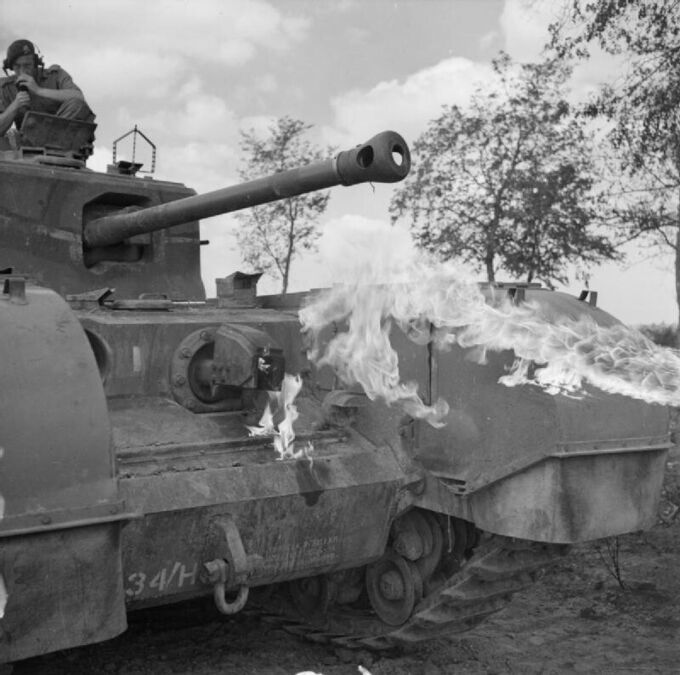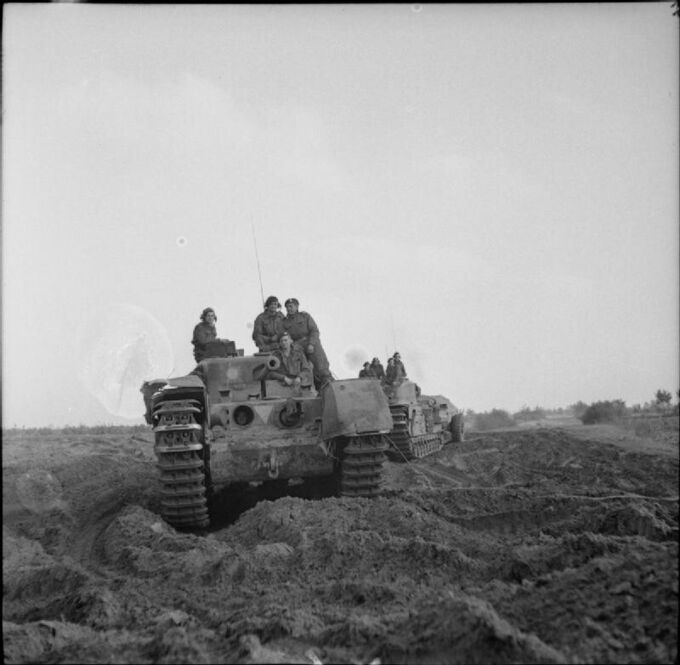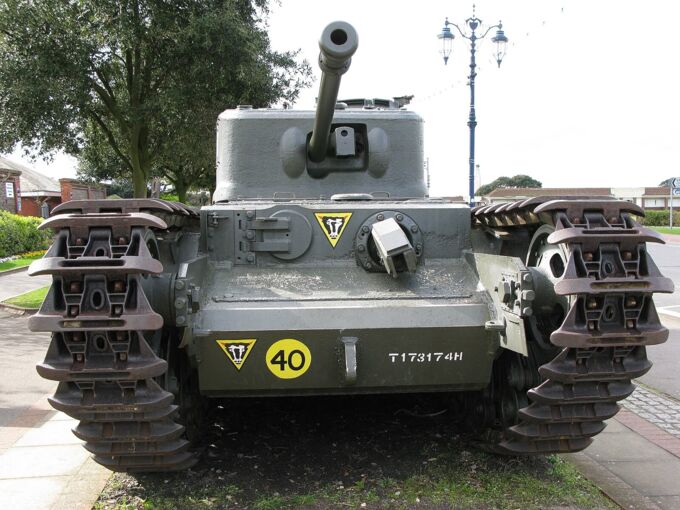In War Thunder, the Churchill Crocodile is generally considered a bit of an oddball as its signature flamethrower is useless against the vast majority of opponents it faces. However, on the battlefields of Western Europe in the 1940s, it was anything but funny for those soldiers unlucky enough to fight against a unit equipped with these armoured dragons.
Genesis and Design
In 1943, as the Allies were gearing up for D-Day, a need was found for specialised tanks to assist in the initial beach assaults, and then the gruelling advance into occupied Europe. Lessons from the ill-fated Dieppe Raids had been learnt well by British and Commonwealth forces, and so the 79th Armoured Division was created under the command of Major General Percy Hobart to come up with new armoured fighting vehicles to assist in these operations.
Hobarts' Funnies, as they were known, were converted Churchill or M4 Sherman tanks. Examples included the Churchill ARK (Armoured Ramp Carrier — a Churchill with a folding road in place of the turret); the Churchill Bobbin (a self-deploying road); and the flail-equipped mine-clearing Sherman Crab. By far the most fearsome, however, was the Churchill Crocodile.
During the Dieppe Raids, a handful of Churchill Mk II tanks fitted with flamethrowers were fielded — known as Churchill Okes. Although all of these Okes were lost, their effectiveness was noted, leading to work beginning on fitting flame projectors to Mk IV tanks. Major General Hobart saw one of these in a demonstration and requested that work on the Crocodile be continued, which eventually, led to a kit which, in theory, (though rarely in practice) could be fitted by REME to any Churchill Mk VII to turn it into a Crocodile. Usually, however, Crocodiles were supplied to specially trained units complete with their flamethrowers and trailers.
The Crocodile’s design was very simple: a large trailer behind the tank carried a tank of combustible fuel, which was fed through a pipe underneath the tank to the projector at the front. The fuel was propelled by tanks of compressed nitrogen, also mounted in the trailer. The trailers contained enough fuel for 80 seconds of firing and could be quickly jettisoned if damaged or empty — for comparison, the Flamethrower, Portable, Mark II used by British and Commonwealth infantry could only manage 10 seconds of firing and had a range of only about 37m. The Crocodiles also kept their primary armament, the Ordnance QF 75mm cannon, alongside its coaxial BESA machine gun. This was unlike many other flamethrower tanks of the time, which often sacrified their main guns in lieu of flamethrowers.
Although the British Army had experimented early in the war with bolting flamethrowers onto everything from unarmoured lorries to Universal Carriers (known as Wasps when fitted with flamethrowers); the Churchill Crocodile was by far the most successful design of them all. Its thick armour and formidable terrain-conquering abilities, courtesy of the tried and tested Churchill hull, meant it could reach even the most inaccessible enemy positions to keep up the pressure. The large fuel capacity also allowed it to engage in much more sustained fire support than other, lighter, flame-throwing units.
Combat History
The Crocodile proved invaluable during the fierce fighting through Normandy as part of the 79th Armoured Division. Small units of Crocodiles and other tanks from this division were attached to other Allied units to assist them in their advances. Crocodiles supported the US Army at the Battle of Brest and the 53rd (Welsh) Division’s assault on Hertogenbosch.
The thick armour, large size, and flame projector made it ideal for assisting Allied troops fighting through the dense French bocage which caused many units trouble. It was also specially noted for its aptitude at clearing entrenched enemy positions, something that it would excel in during the war as a whole. When attacking reinforced fortifications such as bunker networks, Crocodiles would act in concert with Churchill AVREs. The AVRE’s massive bomb would open cracks in the concrete positions, allowing the burning liquid from the Crocodiles' flame projectors to seep inside and flush out the enemy.
Similarly, it was noted by British commanders that when combined with supporting infantry, the very sight of the Crocodiles would cause enemy units to outright surrender, rather than face the horrifying prospect of a fiery death. On several occasions, Crocodiles would engage in a show of force just outside an occupied village, while British infantry moved towards it alongside them. When they got there, the enemy surrendered without a single shot being fired. Over the course of 31 engagements in Normandy, Crocodiles were responsible for the deaths of 154 men with its flames, but caused over 5,000 to surrender. Some German officers are reported to have called the tank “un-British”.
This impressive combat record came at a price, however. In combat, enemy units learned to recognise Crocodiles and would focus on destroying them first — as would happen with Sherman Fireflies. Often, captured crews of Crocodiles were summarily executed in a similar manner to captured snipers, such was the terror they inspired. Similarly, the MoD considered some elements of the Crocodile’s design to be so secret that they would go to extreme lengths to ensure the tanks were not captured, including using airstrikes to destroy un-recoverable vehicles.
In addition to combat, some Crocodiles were present for the liberation of the Bergen-Belsen Concentration Camp in 1945. When British medics declared that the camp was ridden with typhus and lice, the survivors were moved to a nearby former Panzer camp and Crocodiles and flamethrower-equipped Universal Carriers incinerated the appalling huts to stamp out the epidemic.
The US Army also showed interest in the Crocodile, so much so that the British supplied them with Crocodile conversion kits for Sherman tanks so that they could create their own Sherman Crocodiles. The Americans attempted to develop their own flamethrower-toting Shermans, but this failed so they went back to the converted Sherman Crocodiles, using them successfully during Operation Grenade in a similar manner to the Churchills.
Post-war
After the cessation of hostilities in Europe in 1945, there was very little need for the Crocodiles, like much of the powerful wartime military Britain had built up. Although a contingent of 250 Crocodiles had been earmarked for deployment in the Far East, the war ended there before they could be shipped out.
Many Crocodiles were retired, as were the rest of Hobart’s Funnies as they were replaced with purpose built designs such as the Centurion AVRE. More modern designs such as the Centurion replaced the other Churchills in active service, but a few Crocodiles were retained, having no equivalent replacement. These served in the Korean War in the early 1950s, where their flamethrowers and trailers were usually removed. Shortly after the end of the war, the last Crocodiles were retired.
Conclusion
Despite their somewhat average in-game status — they aren’t much more effective than the Churchill Mk VII except against open-topped vehicles — the Crocodile was perhaps one of the most potent weapons in the British Army’s arsenal during the Second World War. Its status as terror weapon par excellence — when used correctly — is remembered to this day, and many nations have tried to emulate its success, with varying results.
Several of these old dragons can now be seen as static monuments, especially in Normandy and England, their fires quenched by 80 years spent on plinths.
Sources
- Wikipedia 9/6/2025
- Tank Encyclopedia 9/6/2025
- Imperial War Museums Website 9/6/2025
- Normandy War Guide 16/6/2025 — interesting set of reports of the Crocodiles’ usage.
Photo of static display tank: geni, CC BY-SA 4.0 <https://creativecommons.org/licenses/by-sa/4.0>, via Wikimedia Commons
Other photos are in the public domain.







